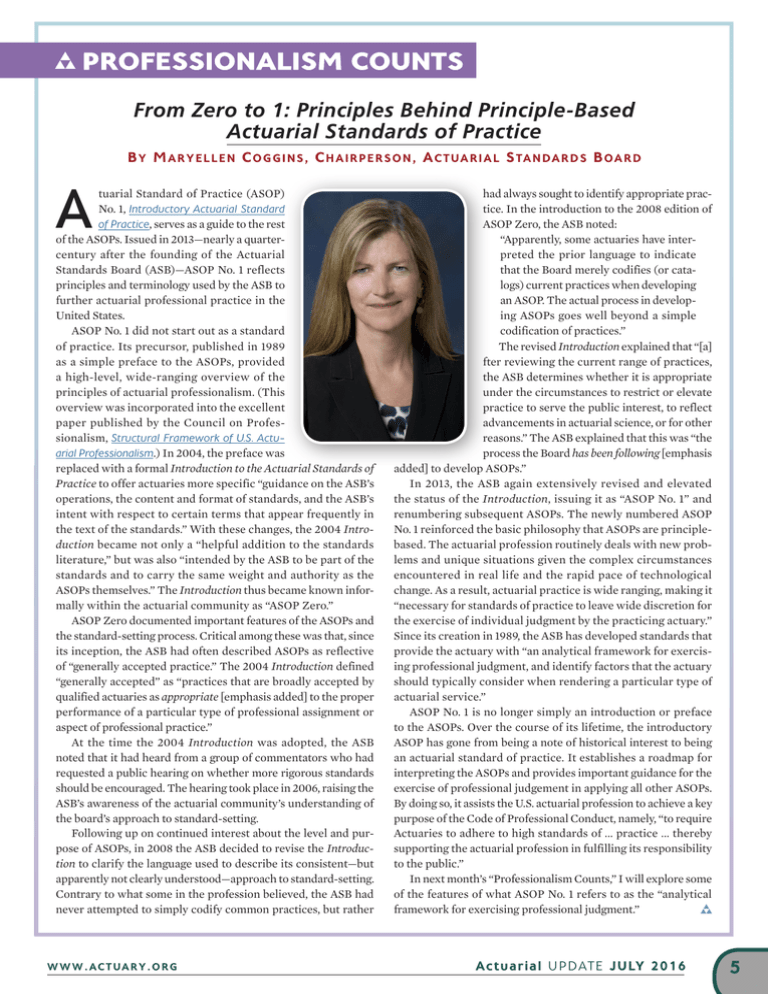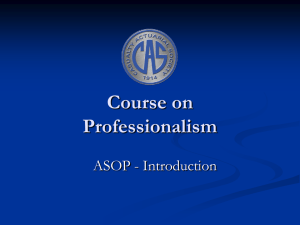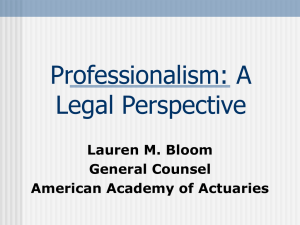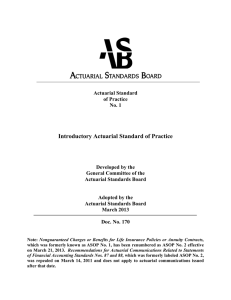From Zero to 1: Principles Behind Principle
advertisement

From Zero to 1: Principles Behind Principle-Based Actuarial Standards of Practice B y M a r y e l l e n C o g g i n s , C h a i r p e r s o n , A c t ua r i a l S ta n da r d s B oa r d A tuarial Standard of Practice (ASOP) No. 1, Introductory Actuarial Standard of Practice, serves as a guide to the rest of the ASOPs. Issued in 2013—nearly a quartercentury after the founding of the Actuarial Standards Board (ASB)—ASOP No. 1 reflects principles and terminology used by the ASB to further actuarial professional practice in the United States. ASOP No. 1 did not start out as a standard of practice. Its precursor, published in 1989 as a simple preface to the ASOPs, provided a high-level, wide-ranging overview of the principles of actuarial professionalism. (This overview was incorporated into the excellent paper published by the Council on Professionalism, Structural Framework of U.S. Actuarial Professionalism.) In 2004, the preface was replaced with a formal Introduction to the Actuarial Standards of Practice to offer actuaries more specific “guidance on the ASB’s operations, the content and format of standards, and the ASB’s intent with respect to certain terms that appear frequently in the text of the standards.” With these changes, the 2004 Introduction became not only a “helpful addition to the standards literature,” but was also “intended by the ASB to be part of the standards and to carry the same weight and authority as the ASOPs themselves.” The Introduction thus became known informally within the actuarial community as “ASOP Zero.” ASOP Zero documented important features of the ASOPs and the standard-setting process. Critical among these was that, since its inception, the ASB had often described ASOPs as reflective of “generally accepted practice.” The 2004 Introduction defined “generally accepted” as “practices that are broadly accepted by qualified actuaries as appropriate [emphasis added] to the proper performance of a particular type of professional assignment or aspect of professional practice.” At the time the 2004 Introduction was adopted, the ASB noted that it had heard from a group of commentators who had requested a public hearing on whether more rigorous standards should be encouraged. The hearing took place in 2006, raising the ASB’s awareness of the actuarial community’s understanding of the board’s approach to standard-setting. Following up on continued interest about the level and purpose of ASOPs, in 2008 the ASB decided to revise the Introduction to clarify the language used to describe its consistent—but apparently not clearly understood—approach to standard-setting. Contrary to what some in the profession believed, the ASB had never attempted to simply codify common practices, but rather www . a c t u a r y . o r g had always sought to identify appropriate practice. In the introduction to the 2008 edition of ASOP Zero, the ASB noted: “Apparently, some actuaries have interpreted the prior language to indicate that the Board merely codifies (or catalogs) current practices when developing an ASOP. The actual process in developing ASOPs goes well beyond a simple codification of practices.” The revised Introduction explained that “[a] fter reviewing the current range of practices, the ASB determines whether it is appropriate under the circumstances to restrict or elevate practice to serve the public interest, to reflect advancements in actuarial science, or for other reasons.” The ASB explained that this was “the process the Board has been following [emphasis added] to develop ASOPs.” In 2013, the ASB again extensively revised and elevated the status of the Introduction, issuing it as “ASOP No. 1” and renumbering subsequent ASOPs. The newly numbered ASOP No. 1 reinforced the basic philosophy that ASOPs are principlebased. The actuarial profession routinely deals with new problems and unique situations given the complex circumstances encountered in real life and the rapid pace of technological change. As a result, actuarial practice is wide ranging, making it “necessary for standards of practice to leave wide discretion for the exercise of individual judgment by the practicing actuary.” Since its creation in 1989, the ASB has developed standards that provide the actuary with “an analytical framework for exercising professional judgment, and identify factors that the actuary should typically consider when rendering a particular type of actuarial service.” ASOP No. 1 is no longer simply an introduction or preface to the ASOPs. Over the course of its lifetime, the introductory ASOP has gone from being a note of historical interest to being an actuarial standard of practice. It establishes a roadmap for interpreting the ASOPs and provides important guidance for the exercise of professional judgement in applying all other ASOPs. By doing so, it assists the U.S. actuarial profession to achieve a key purpose of the Code of Professional Conduct, namely, “to require Actuaries to adhere to high standards of ... practice ... thereby supporting the actuarial profession in fulfilling its responsibility to the public.” In next month’s “Professionalism Counts,” I will explore some of the features of what ASOP No. 1 refers to as the “analytical framework for exercising professional judgment.” A c t u a r i a l U P DAT E J U LY 2 0 1 6 5



